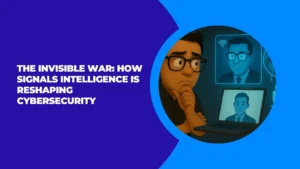Physical Address
304 North Cardinal St.
Dorchester Center, MA 02124
Physical Address
304 North Cardinal St.
Dorchester Center, MA 02124

Cybersecurity isn’t just about patching holes anymore. It’s a high-stakes arms race where attackers constantly evolve, and defenders have to stay one step ahead without even knowing exactly what’s coming. The battleground isn’t just code and firewalls, it’s information itself.
To win that fight, many organizations are starting to think like intelligence agencies. Instead of waiting for alerts to go off, they’re learning how to pick up on subtle signals, patterns, and digital noise that might hint at trouble before it hits. This approach, rooted in signals intelligence (SIGINT), is becoming a powerful edge in modern cyber defense.
The shift toward proactive security isn’t about paranoia; it’s about preparation. Businesses of all sizes are realizing that traditional defenses only work when threats are predictable.
But today’s cyberattacks often come through unconventional channels or start with signals that only appear suspicious in hindsight. That’s why a more intelligence-driven mindset is emerging.
Signals intelligence, or SIGINT, is the process of intercepting and analyzing electronic communications such as radio waves, satellite transmissions, and internet traffic. Historically, military and government agencies have used it to monitor adversaries and anticipate conflict.
But the same techniques that once uncovered enemy movements are now being used to spot early signs of cyberattacks. Threat actors rarely strike out of nowhere.
They test defenses, probe systems, and leave digital breadcrumbs along the way. SIGINT tools help track those signals, surfacing threats that might otherwise go unnoticed.
What makes SIGINT especially valuable is its ability to collect intelligence passively. Instead of launching probes or scans that might trigger defenses, SIGINT tools quietly observe. That passive nature allows organizations to remain undetected while gathering the context they need to mount a stronger defense.
Intelligence agencies have used SIGINT for decades to stay ahead of threats. Now, some of the same principles are creeping into the corporate world. Companies with a lot to lose, including banks, tech firms, and utilities, are starting to think like spies.
They’re investing in tools that go beyond basic monitoring. Instead of waiting for malware to show up, they look for early warning signs such as suspicious domain registrations, traffic anomalies, or behavior that mimics known threat actors. Some even analyze chatter across forums and marketplaces on the dark web to see if their name is coming up.
This shift reflects a new mindset. You can’t just build taller walls; you need to know what’s happening outside them.
Large enterprises aren’t the only ones leaning into this strategy. Managed service providers, threat intelligence firms, and even startups are offering SIGINT-inspired tools tailored to specific industries. In sectors like healthcare or logistics, where a breach can disrupt lives or supply chains, these insights can be mission-critical.
Catching a threat in progress isn’t good enough anymore. The real goal is spotting it before it starts, when it’s still in planning mode.
One of the strengths of SIGINT-inspired approaches is recognizing behavior patterns. Maybe a phishing campaign is being staged with a domain that looks almost, but not quite, like your company’s. Or maybe your server is seeing an unusual amount of attention from IPs tied to past breaches.
None of these, on their own, are smoking guns. But together, they form a picture of what might be unfolding. And that picture gives defenders time to prepare.
Being proactive also helps limit the blast radius. If a team can quarantine a vulnerability or block a compromised account before it spreads, they’re not just avoiding damage; they’re controlling the narrative and limiting recovery costs.
Many cybersecurity teams already collect threat intelligence from various feeds. What makes SIGINT different is the scope and synthesis. It’s not just about IP blacklists or malware hashes.
It’s about pulling together fragmented pieces such as network traffic, infrastructure metadata, and emerging tactics, then connecting the dots to understand what might be coming next.
It’s less whack-a-mole and more weather radar. Instead of fighting each fire as it starts, you’re watching the sky and tracking where the storms are likely to hit.
With great data comes great responsibility. As businesses adopt SIGINT-style tools, they risk crossing lines they may not even see.
Monitoring communications and collecting metadata, even for security purposes, can raise serious privacy concerns. It’s easy to justify when you’re trying to stop a breach. But it can look a lot like surveillance, especially if there’s no clear policy on what’s collected and why.
Transparency matters. So does restraint. Collect what you need, not everything you can. And make sure users, whether employees or customers, understand what’s happening and how their data is protected. Good cybersecurity doesn’t require trading away trust.
Some countries already regulate how data can be monitored and stored, especially across borders. Organizations that operate internationally need to navigate a minefield of privacy laws, including the GDPR and similar frameworks. Ethical cybersecurity doesn’t just prevent threats, it respects boundaries.
The lines between cyber defense and intelligence gathering are getting blurrier by the day. What used to be reserved for national security is now shaping how businesses defend themselves in real time.
This isn’t about turning every IT department into a spy agency. It’s about evolving from reactive security to active awareness. Using the right tools, teams can monitor the broader threat landscape, spot patterns early, and respond faster, before the damage is done.
Signals intelligence won’t solve every problem. But in a world where threats are increasingly sophisticated, coordinated, and persistent, it offers a new way of thinking, one rooted in foresight instead of damage control. The next generation of cybersecurity professionals won’t just know how to respond. They’ll know how to anticipate.
As attackers get smarter and more patient, the defenders who thrive will be the ones who can listen better. In the invisible war of the internet, awareness is everything. Signals intelligence might just be the most valuable tool you’ve never thought to use.